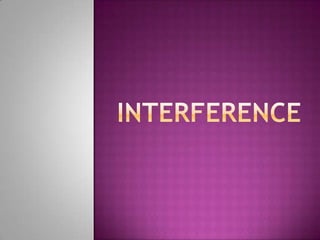Interference
•Transferir como PPTX, PDF•
35 gostaram•31,411 visualizações
This document discusses interference, which occurs when two or more waves overlap. There are two types of interference: constructive and destructive. Constructive interference occurs when waves are displaced in the same direction and amplitudes add, while destructive interference occurs when they are displaced in opposite directions and amplitudes subtract. The document provides examples of interference in light, radio, acoustic, and water waves. It describes Young's double-slit experiment, which demonstrated that light behaves as waves that can interfere and was evidence against the particle theory of light.
Denunciar
Compartilhar
Denunciar
Compartilhar

Recomendados
Recomendados
Mais conteúdo relacionado
Mais procurados
Mais procurados (20)
Destaque
Destaque (20)
Notes for 12th Physics - Interference and Diffraction

Notes for 12th Physics - Interference and Diffraction
Wireless Communication and Networking by WilliamStallings Chap2

Wireless Communication and Networking by WilliamStallings Chap2
Semelhante a Interference
Semelhante a Interference (20)
interference_reflection_refraction_diffraction.pptx

interference_reflection_refraction_diffraction.pptx
Mais de Gulfam Hussain
Mais de Gulfam Hussain (20)
Tensile, Impact and Hardness Testing of Mild Steel

Tensile, Impact and Hardness Testing of Mild Steel
Properties of materials / Mechanical Properties of materials

Properties of materials / Mechanical Properties of materials
Interference
- 2. Presented to Sir Ramzan Presented by Sania MME-12-26. Asia Abbas MME-12-27. Benish Yaqoob MME-12-28
- 3. INTERFERENCE Interference is an effect that occurs when two or more waves overlap. In general, the individual waves do not affect one another, and the total wave amplitude at any point in space is simply the sum of the amplitudes of the individual waves at that point.
- 4. TYPES OF INTERFERENCE Constructive interference Destructive interference Constructive Interference It is a type of interference where the two interfering waves have a displacement in the same direction
- 5. Constructive interference is observed at any location where the two interfering waves are displaced upward
- 6. It is also observed when both interfering waves are displaced downward
- 7. Destructive Interference It is a type of interference where the two interfering waves have a displacement in the opposite direction.
- 8. The principle of superposition of waves states that when two or more waves are incident on the same point, the total displacement at that point is equal to the vector sum of the displacements of the individual waves. If a crest of a wave meets a crest of another wave of the same frequency at the same point, then the magnitude of the displacement is the sum of the individual magnitudes, this is constructive interference.
- 9. If a crest of one wave meets a trough of another wave then the magnitude of the displacements is equal to the difference in the individual magnitudes, this is known as destructive interference. Resultant wave Wave 1 Wave 2 Constructive interference Destructive interference
- 10. Constructive interference occurs when the phase difference between the waves is a multiple of 2π Destructive interference occurs difference is an odd multiple of π Interference when the is a phenomenon in which two waves superimpose to form a resultant wave of greater or lower amplitude
- 11. If the difference between the phases is intermediate between these two extremes, then the magnitude of the displacement of the summed waves lies between the minimum and maximum values. Mechanism 1 .Between two plane waves 2 .Between two spherical waves 3 .Radio 4.Optical interference
- 12. Interference effects can be observed with all types of waves, for example Light Radio Acoustic Surface water waves.
- 14. (Thomas Young) Young's interference experiment, also called Young's double-slit interferometer, was the original version of the modern double-slit experiment, performed at the beginning of the nineteenth century by Thomas Young The results of Young's Double Slit Experiment should be very different if light is a wave or a particle.
- 16. In Young's experiment, two very narrow parallel slits, separated by a distance. Monochromatic light, from a distant light-source, passes through the slits and eventually hits a screen.
- 17. The light waves emanating from each slit are superposed on the screen. If the waves are out of phase then destructive interference occurs, resulting in a dark patch on the screen. On the other hand, if the waves are completely in phase then constructive interference occurs, resulting in a light patch on the screen.
